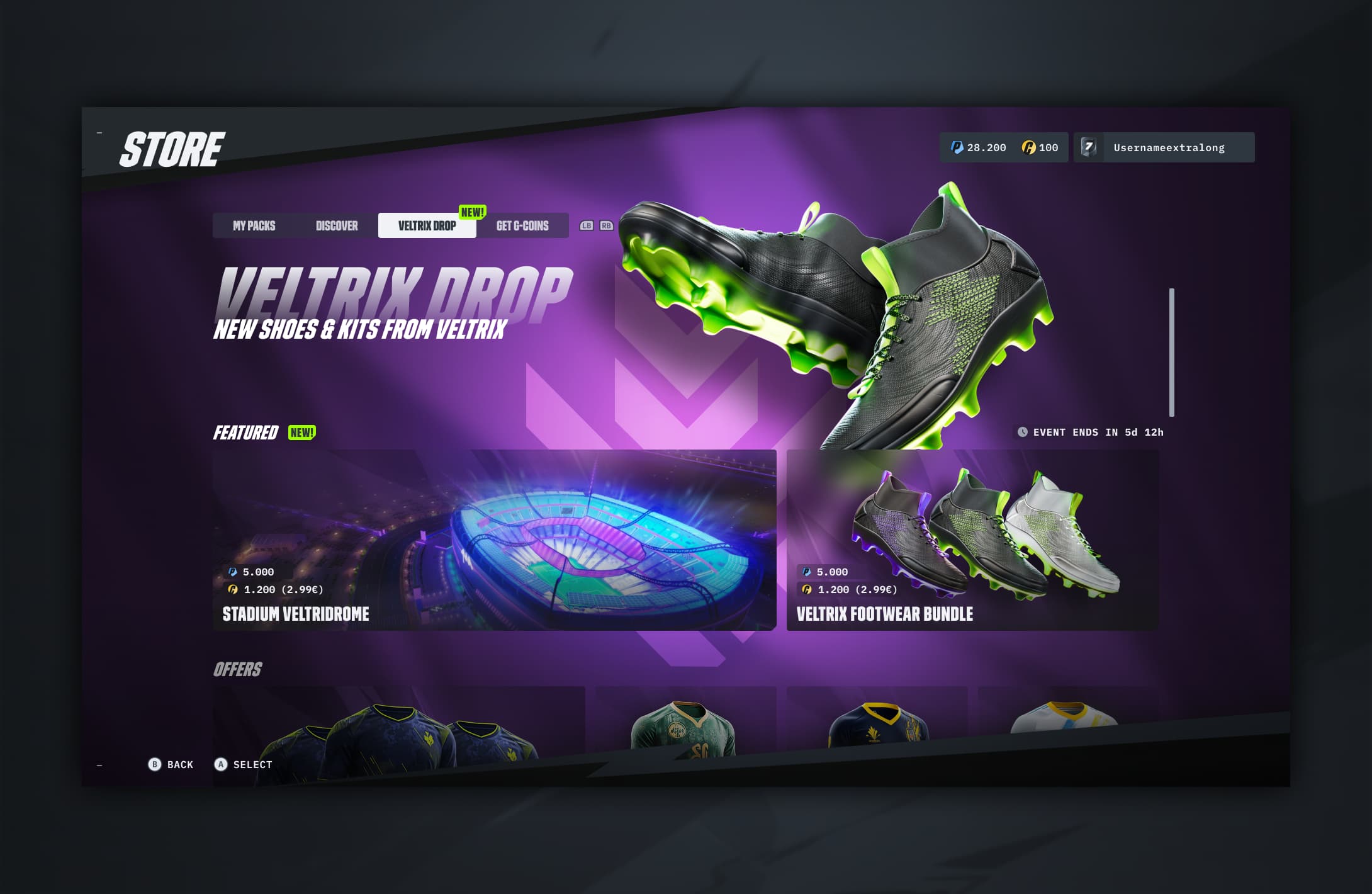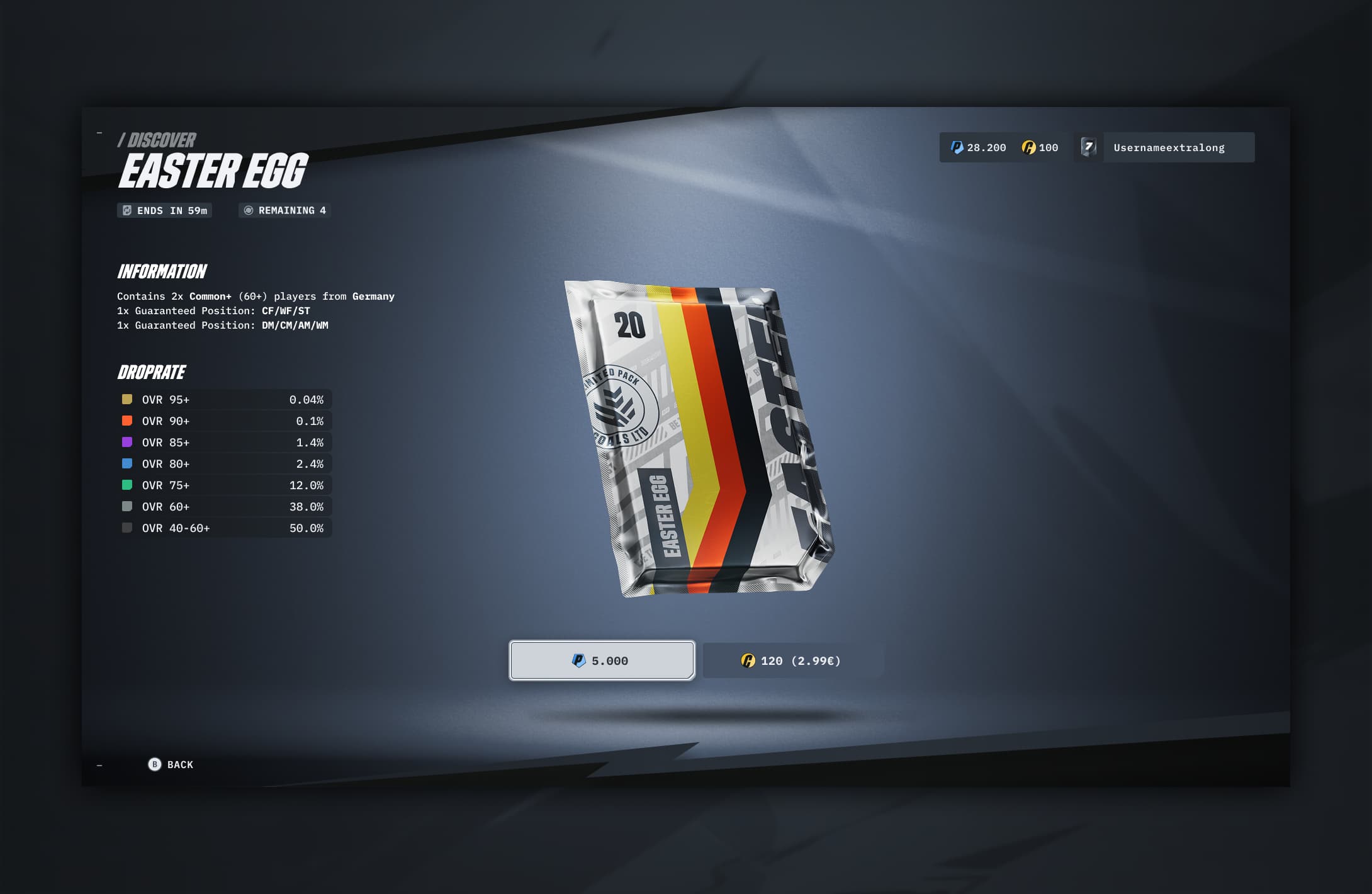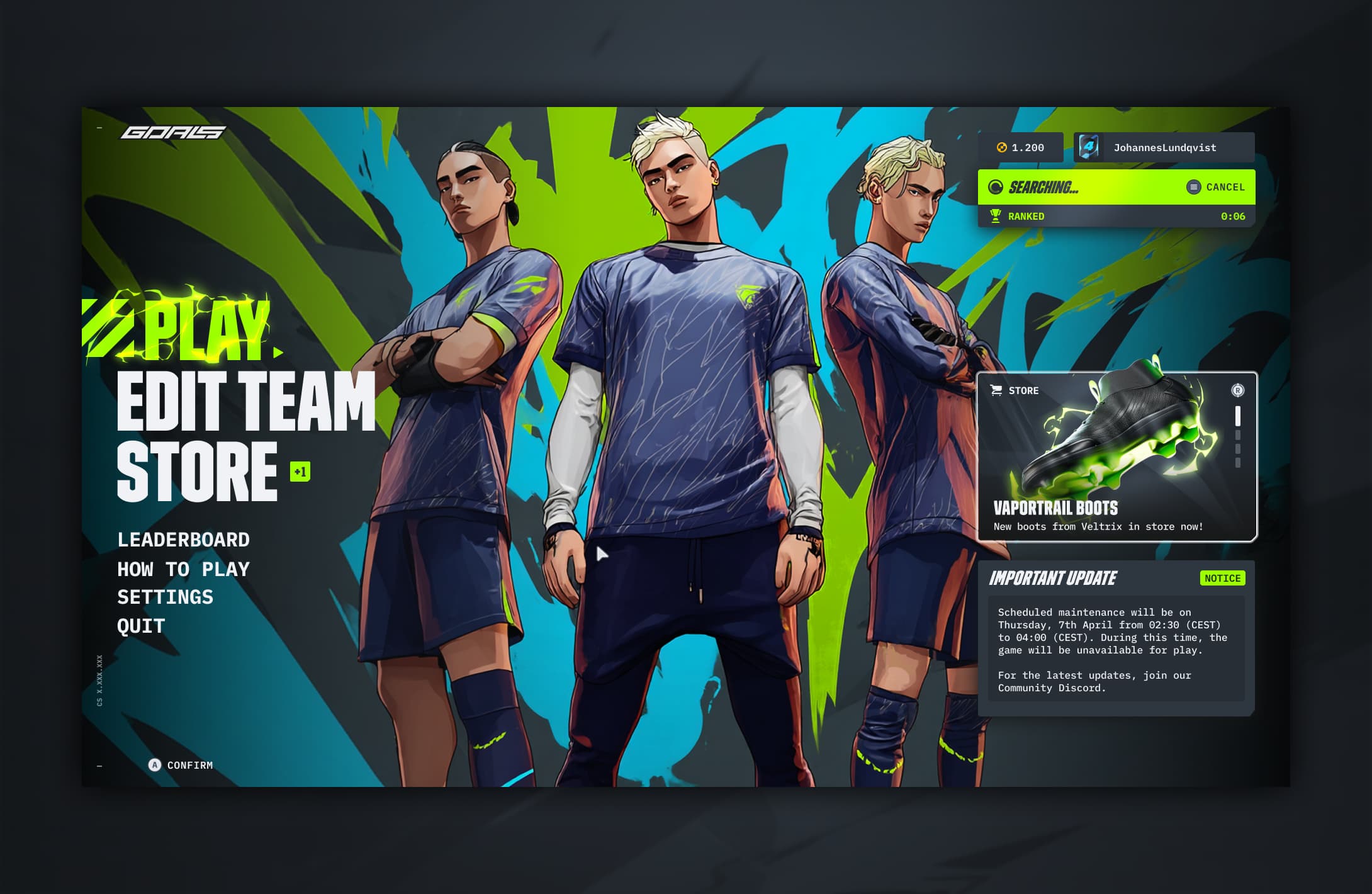
Overview
Crafting the user experience of a competitive football game from the ground up
GOALS is a free-to-play football game built for a global esports audience, with a mission to become the world’s biggest football game. At its core, it offers fast, responsive and skill based gameplay. Combined with a with best in-class user experience it aims to meet the expectations of a modern live service market.
Beyond core gameplay, the game revolves around a popular team-building card mechanic, where players collect and manage virtual cards representing fictional football players. Custom squads are assembled and used to compete across various online modes. Cards vary in rarity and strength, and can be acquired through trading, challenges, or by purchasing with real or virtual currency, which is the primary means of monetizing the game.
To comply with my non-disclosure agreement I have excluded confidential information in this case study. The presented information is my own and does not necessarily reflect the views of the client.
Year
2023-2025
Client
GOALS is a gaming startup developing a competitive, free-to-play football game for esports.
Role & Responsibilities
I collaborated in cross-functional teams alongside designers, developers, and artists to shape the UX and UI of GOALS. Responsibilities ranged from defining core loops, progression mechanics, and engagement systems to creating user flows, wireframes, interactive prototypes, documentation, and high-fidelity designs.
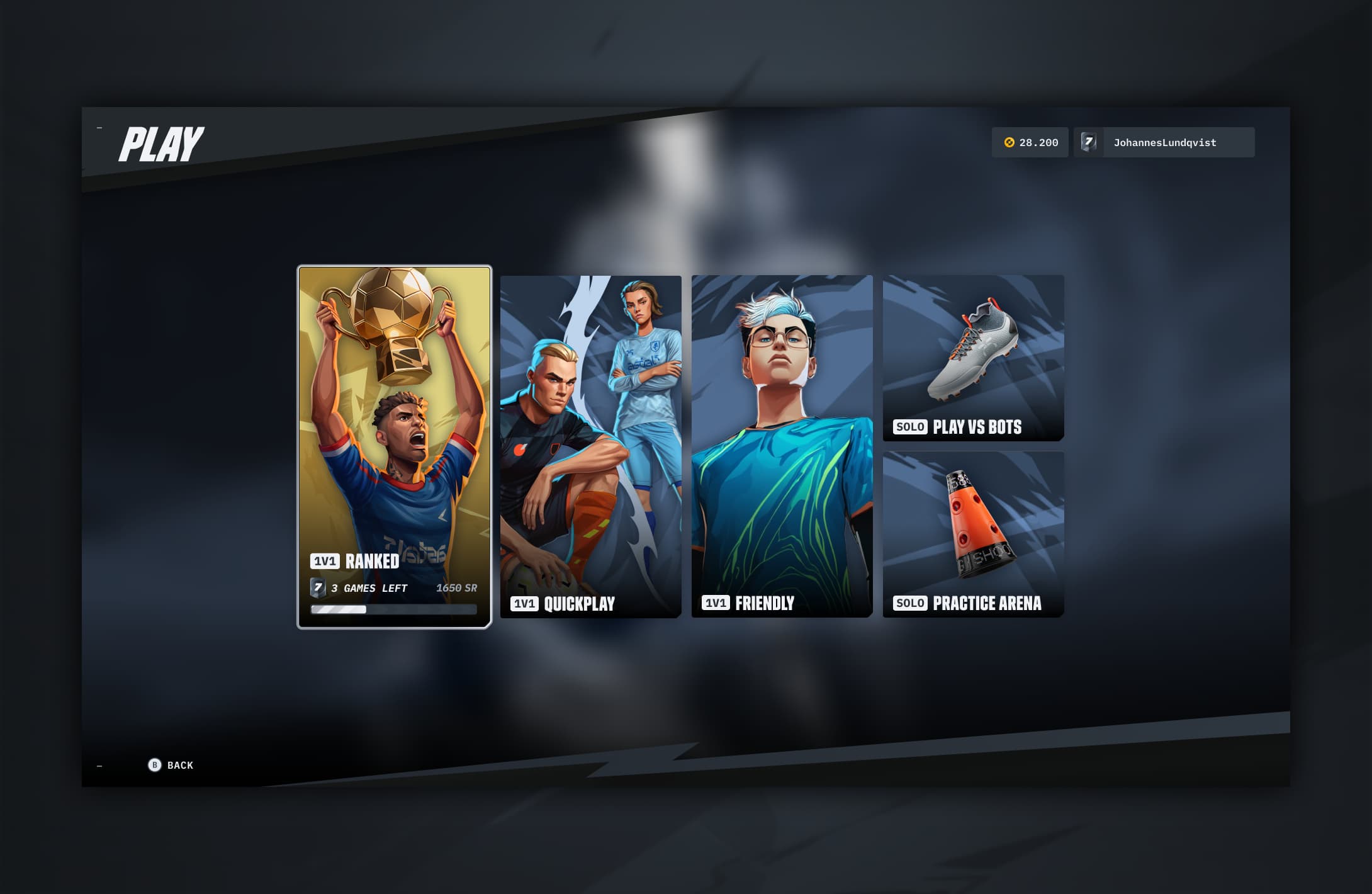
Challenge
Addressing opportunities in the competitive football gaming landscape
For years, the football gaming scene has lacked true competition. With few alternatives, most titles have leaned heavily into realism at the expense of responsiveness, leaving an opportunity for faster and more competitive play.
The opportunities extended beyond gameplay. Rigid annual release cycles left little room for innovation and meaningful improvements, making it difficult to meet evolving player expectations. As a result, the overall user experience in the genre struggled to keep pace with modern standards.
On top of this, high upfront costs and growing hardware demands created barriers for players, making upgrading difficult to justify. Over time, many players stayed on older versions, thus fragmenting the player base. All this while remaining narrowly focused on attracting hardcore football fans, struggling to broaden its appeal to gamers in other genres.
These shortcomings sparked the vision for a new approach: a live service football game designed to deliver ongoing updates, keep content fresh, reduce costs for players, and maintain a unified, active community. Building on the overall vision for the new game, a central question was defined to steer the UX direction:
"How might we reimagine competitve football gaming to attract a broader audience while delivering a modern, scalable user experience within a live service model?"
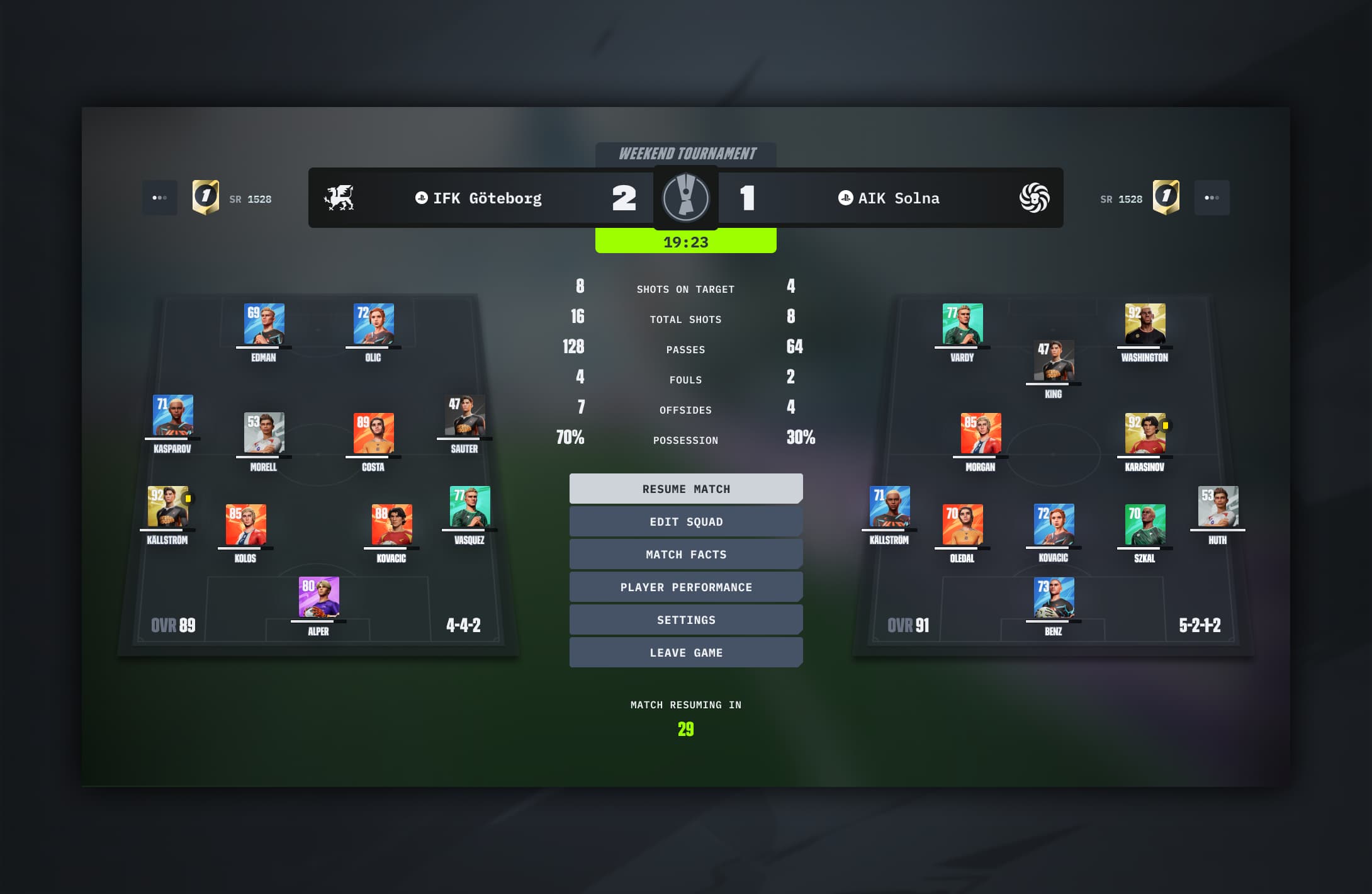
Research
Insights that shaped design decisions
The team at GOALS consisted of a mix of passionate football gaming enthusiasts and professional esports players, bringing deep, firsthand expertise to the project. This provided a solid starting point to begin internal research through stakeholder interviews, helping to uncover perceived market gaps and critical pain points to be addressed for the game to succeed.
Through competitor analyses, I explored both the football gaming landscape and the wider market to uncover opportunities and areas for improvement. This ideation step allowed me to craft targeted survey questions that engaged a dedicated gamer community from an early stage. These findings highlighted where business objectives and player needs intersected, which I turned into a set of core design pillars:
01 Establish consistent interaction patterns across input types to aid accessibility and reinforce muscle memory
02 Ensure a scalable information architecture that supports fast and fluid navigation as content grows
03 Reward long-term commitment while avoiding hard resets of progress
04 Limit pay-to-win mechanics and flatten the power curve to promote competitive integrity
05 Streamline progression and engagement systems to reward skill and strategy over time-intensive completion
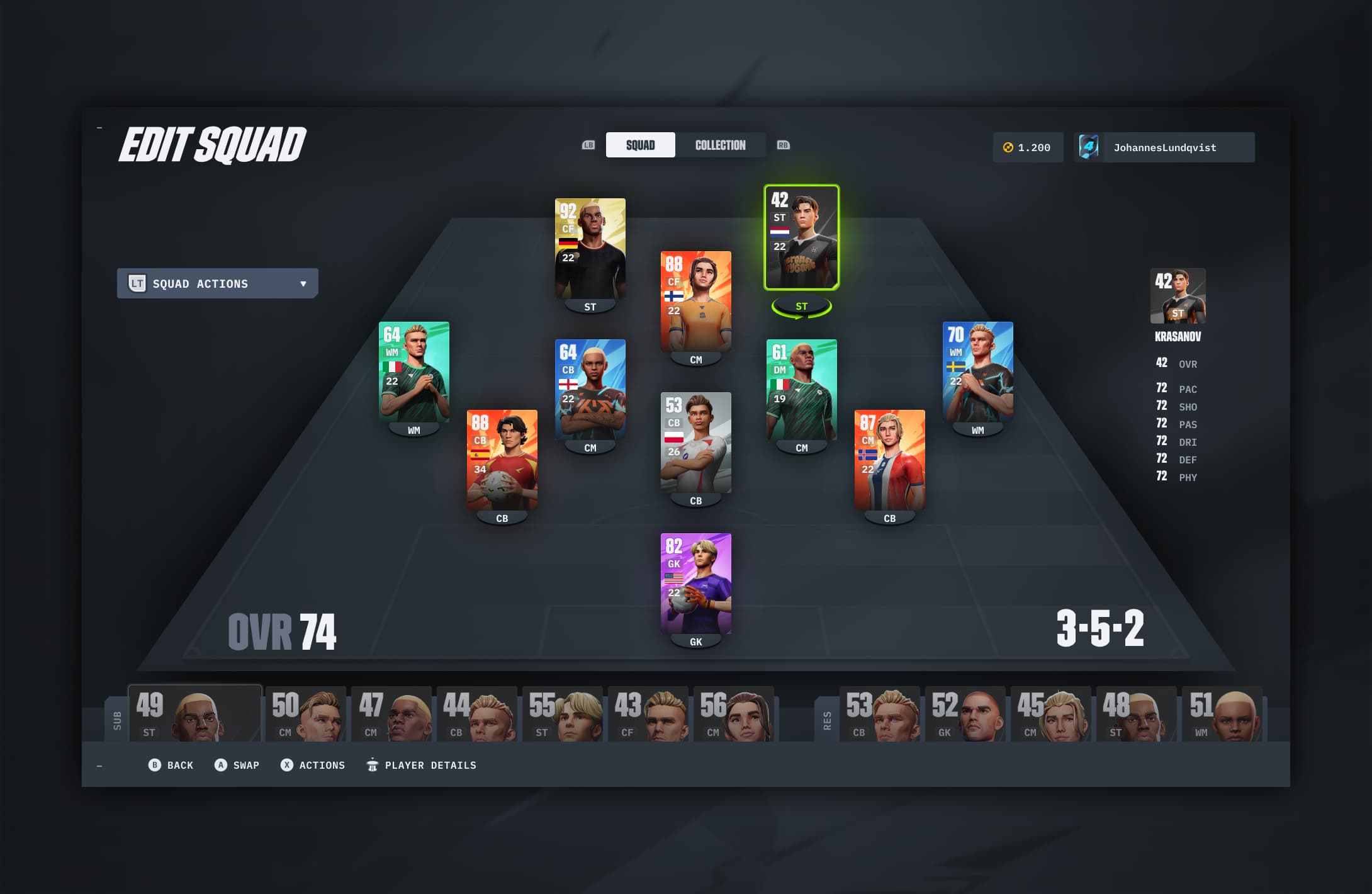
Process
Rapid iteration through lean UX
To keep costs down while finding product-market fit, we began by building on what users already loved about football games and focused research and refinement efforts where it mattered the most. I adopted a lean UX approach, working closely with the core team to swiftly deliver solutions and gather feedback from an engaged community of early testers. This approach allowed us to rely on experience, instinct, and real-time input from users to rapidly iterate and refine ideas as they were tested.
I started by mapping out the general architecture of the core session flow through journey mapping workshops. This highlighted areas with the most uncertainty, helping us prioritize what to test first.
Focusing on designing the most complex and content-heavy screens first allowed me to expose layout constraints and navigation challenges. In turn, this informed a set of foundational design patterns and navigation rules. With this information at hand I started the creation of an atomic component library to drive consistency and faster design deliveries. Core components were implemented in-engine to support rapid development and feature testing.
To mitigate risks and uncertainty associated with the progression and engagement systems, I adopted a horizontal slice approach by keeping designs rough and shaping them just enough to be able to test the underlying assumptions. In parallel, we developed a companion app which was used to evaluate the game economy and various engagement patterns before fully committing to building the features in-game.
By validating ideas with the community in real-world conditions before moving into vertical slice development,we were able to maintain speed and agility while steadily meeting user expectations.
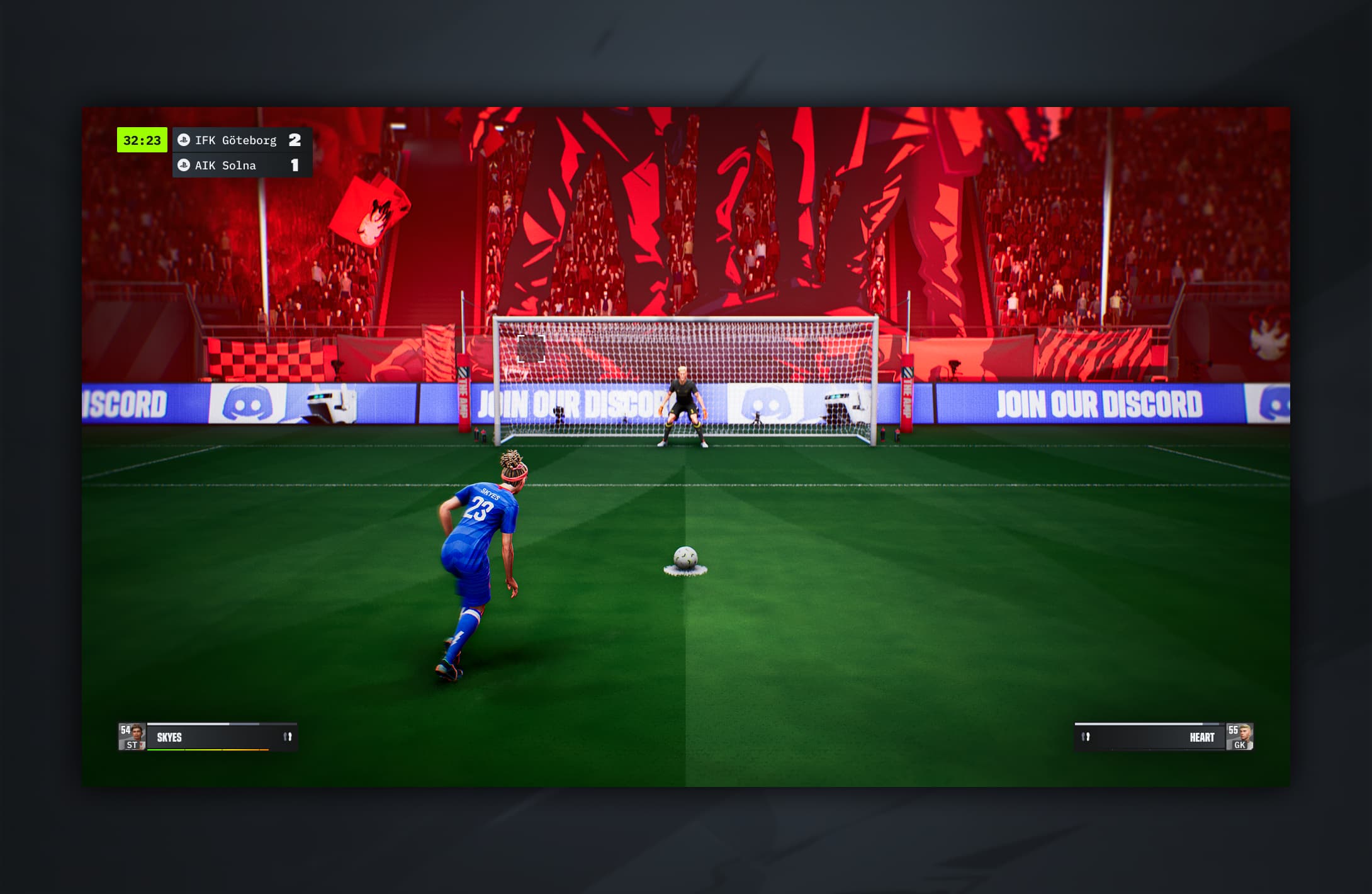
The Solution
Designing for fairness, accessibility, and long-term engagement
Guided by the goals and insights uncovered during research, I approached the design with a focus on creating a user experience that was fair, engaging, and scalable. Every decision aimed to support both newcomers and competitive players, ensuring the game would appeal to a broad audience.
Seamless play across platforms
Building on the principles of making the game accessible to both casual gamers and esports pros, I focused on delivering best-in-class usability across platforms. I designed navigation that allowed users to switch seamlessly between controller and mouse/keyboard, ensuring interactions felt native to each input type without ever feeling like a port or a compromise. In parallel, key flows for the companion app were established so users could manage squads and progression wherever they preferred, keeping gameplay focused and uninterrupted.
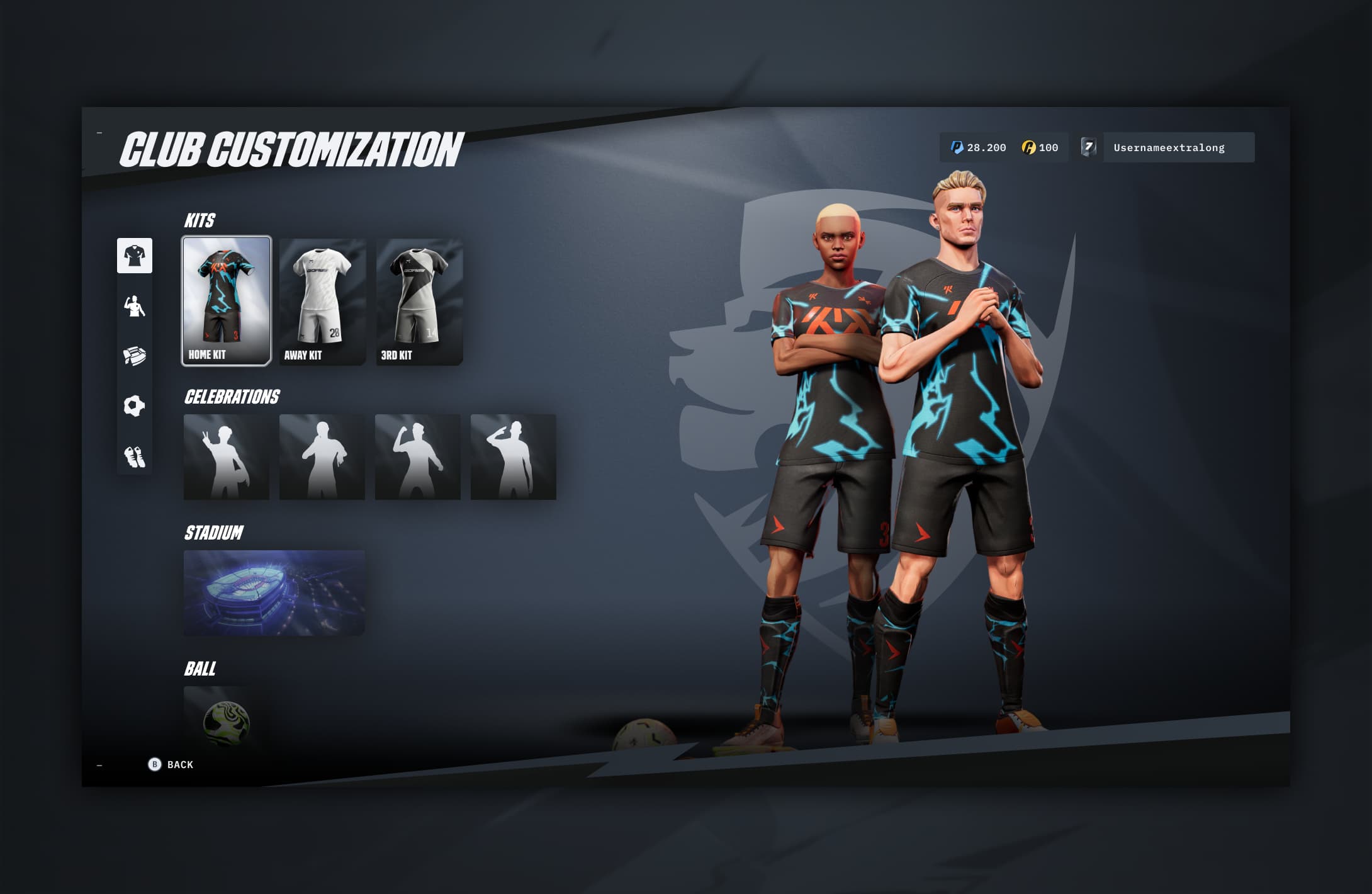
Scalable Modular Interfaces
I prioritized consistent and established interaction patterns to speed up navigation which reinforced muscle memory and helped users familiar with other live service games adapt quickly. Guided by the live service model, I focused on creating systemic, scalable layouts that kept the interface intuitive and manageable even as content grew in size and complexity.
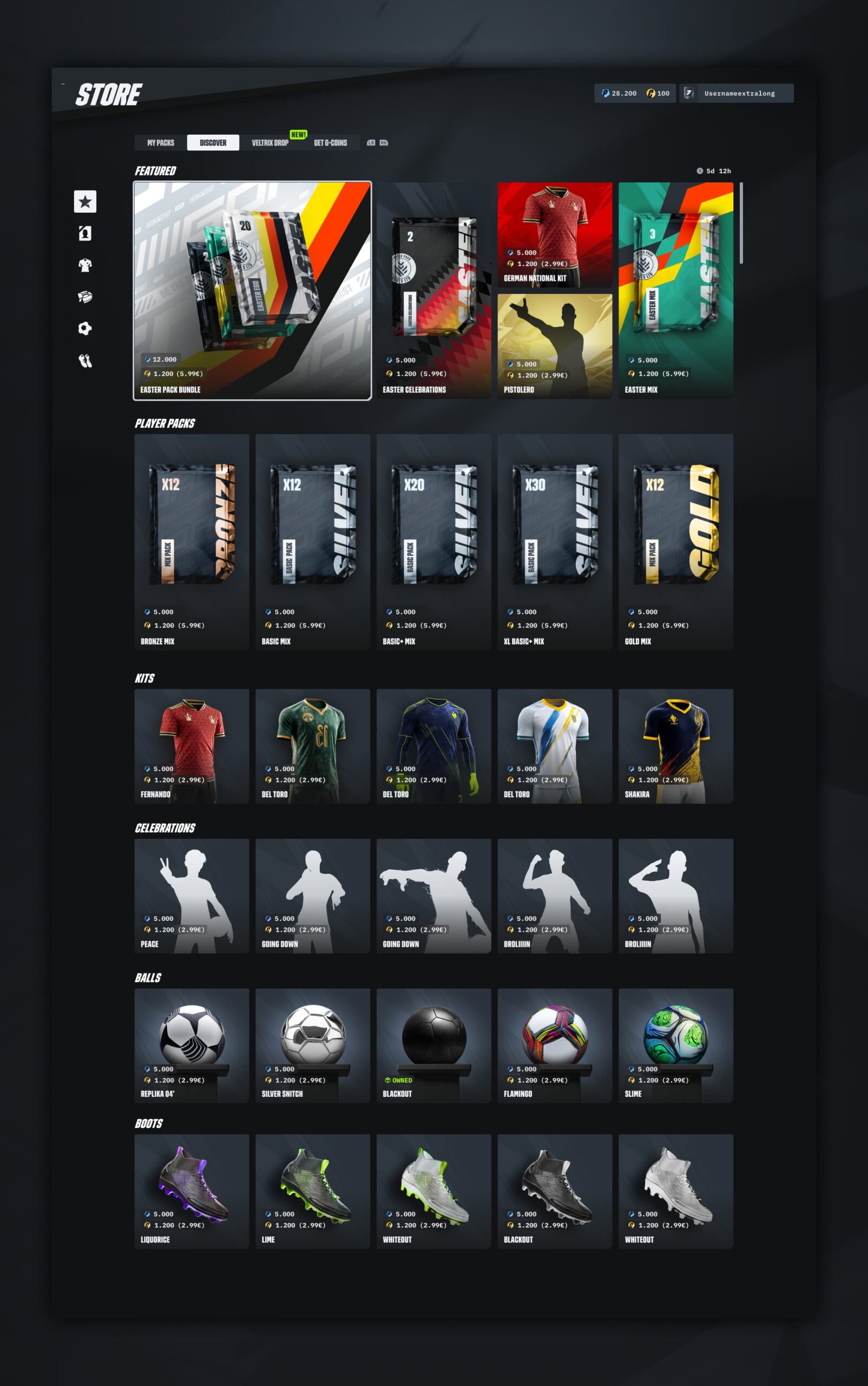
Natural progression without hard resets
By collaborating with the design team, I designed a growth system where players aged, developed, and eventually retired in stages, creating a natural turnover rather than relying on full annual or seasonal resets to level the power curve. This rewarded strategic planning and long-term commitment, providing a steady stream of engaging progression while keeping the power curve balanced between casuals and experienced competitors.
To encourage long-term commitment, retired player cards were designed to evolve into club legends, granting access to special modes and tournaments with unique rewards. By emphasizing progression and strategic decision-making over purchasing top players outright, we created a fairer, more engaging experience that rewarded skill, planning, and commitment rather than grind, luck and spending money.
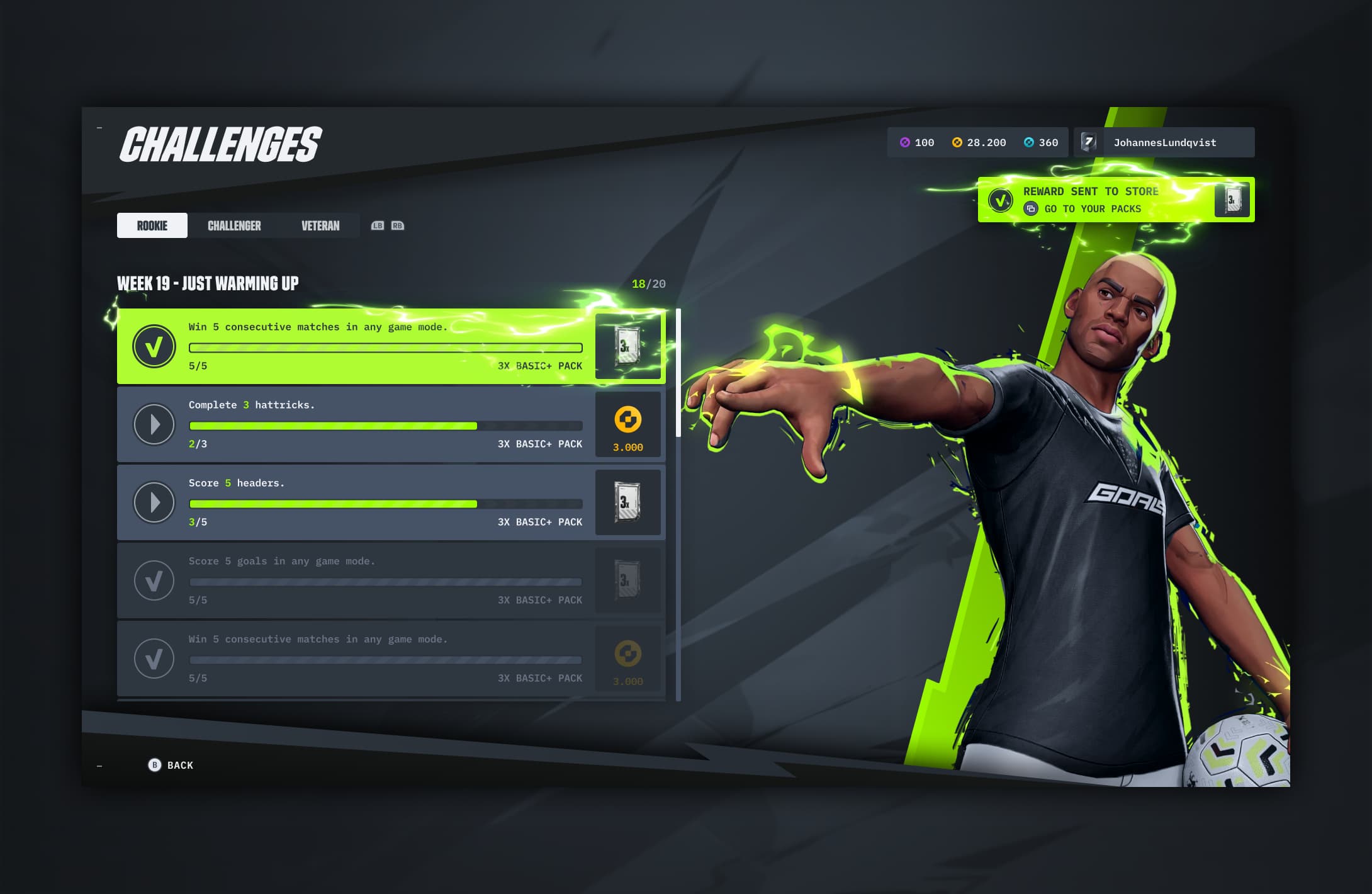
Retention systems that reward choice over grind
To keep players engaged over the long term, various retention systems were designed to feel meaningful and engaging by rewarding strategic choice over sheer time investment or grind.
The Store was designed for scalability and rotation, supporting both everyday content and special events. This design gave the team flexibility to experiment with content and personalized offers. Offering users exclusive cosmetics gave them a way to showcase their digital identity through self-expression. These items also provided bragging rights that signaled dedication and skill, deepening their emotional bond with the game.
To mitigate the luck involved in the unpredictable pack-opening mechanic, I designed a feature called Swaps. It allows users to trade unused cards for new rewards, transforming excess inventory into ongoing value therefore rewarding continuity and persistence. The system also added a layer of strategy, as players needed to decide which swaps to complete since tougher requirements and higher quantities increased the chances of earning better rewards. To remove a sense of grind within the feature, I designed a smart auto-collect feature that streamlines card selection, reducing repetitive manual actions and keeping the focus strategy rather than execution.
Challenges presented tasks that players completed to earn meaningful rewards. At the same time, it served as a soft onboarding system, helping newcomers gradually discover different mechanics and subsystems. Experienced players, on the other hand, could plan which tasks to tackle and in what order, using the interplay between engagement systems to maximize rewards while minimizing effort. By balancing accessibility for new players with strategic depth for veterans, the system felt approachable, engaging, and rewarding for all. Together, these designs drove long-term engagement, strengthened player retention, and helped the team grow a broader, more active audience both in-game and via the companion app.
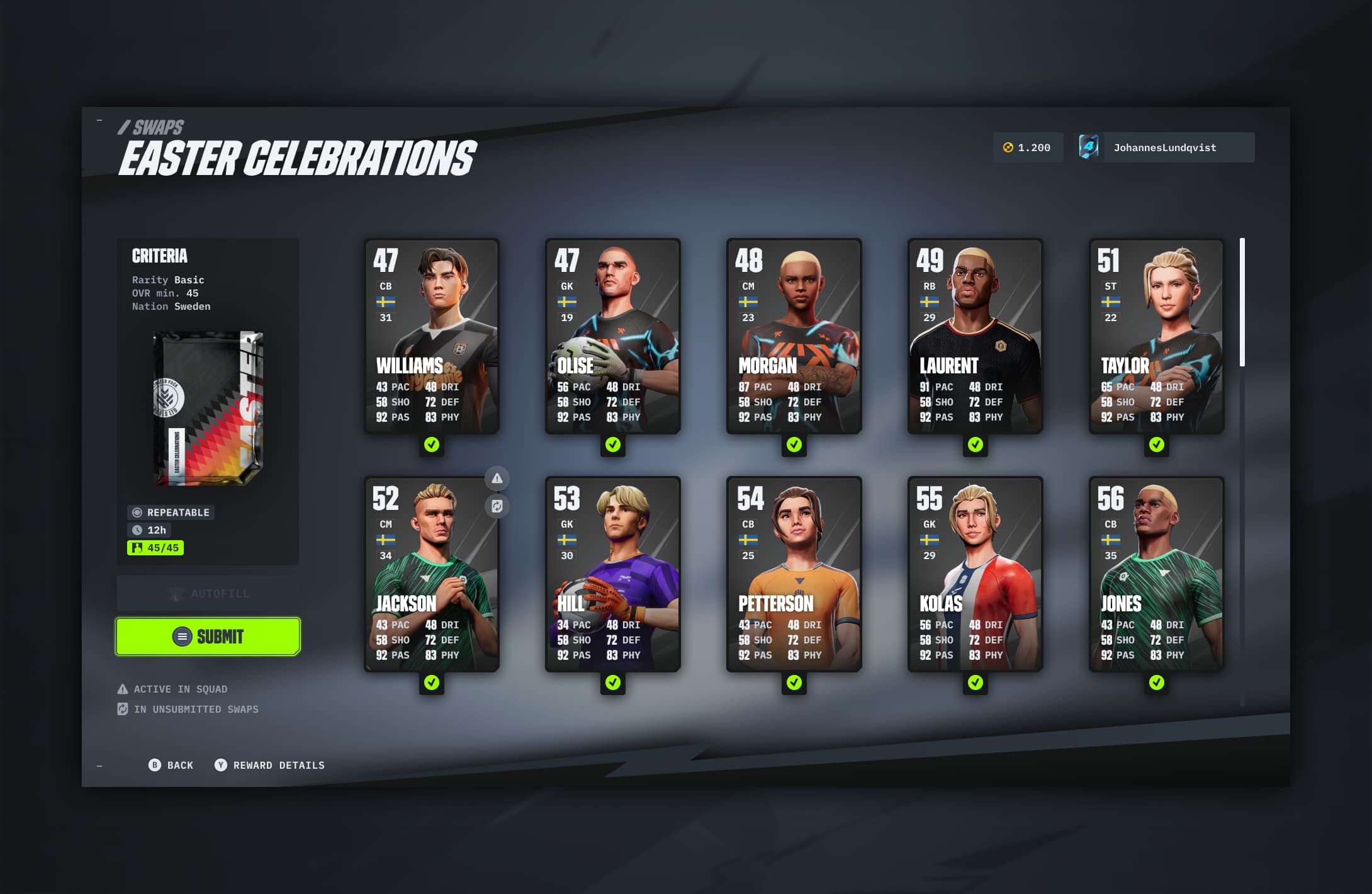
The Outcome
Momentum toward a broader audience
At the time of writing, the game is yet to be released, but early testing shows strong signs of success. Retention and session metrics are trending positively, while qualitative feedback praises intuitive navigation, responsiveness, and usability.
Behind those numbers are real player experiences, with thousands actively engaging with features, experimenting with team building, and sharing feedback that continues to shape the game. Newcomers are onboarded effortlessly, and experienced players enjoy meaningful strategic choices, together validating the design principles formed to shape the vision of the game. These early results have laid the foundation for continued success, building strong momentum toward realizing the vision of creating the world’s largest football game.
